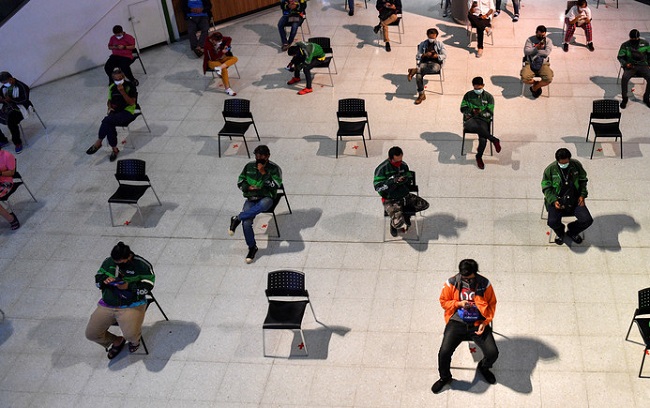Recent days have seen scattered protests across the country denouncing social distance measures; these protests have been coordinated by (among others) a number of well-funded right-wing groups and egged on by all-caps tweets from the President.
The Most Famous Act of Social Distancing
A few protesters waved Confederate flags, brandished automatic guns, or displayed posters supporting anti-vaccine beliefs or conspiracy theories. Screams of “I need a haircut!” and “I despise having to purchase two iced teas in the drive thru!” were heard, the latter from a man who lamented the loss of free refills at sit-down establishments.

Although these “cries of the heart” may pale in contrast to Patrick Henry’s “liberty or death,” the sight of armed white men parading through the streets never fails to get the attention of the media.
The footage could lead one to believe that the United States is a deeply divided nation. We are closer together now than we’ve been in a long time. Many Americans are staying at home despite the high financial and emotional costs.
This extremely large group is currently accomplishing something quite remarkable. Americans back social distance by wide numbers but are concerned that governments will be pressured to relax regulations too rapidly. I can’t think of a more amazing civic-minded gesture than distancing oneself from something or someone.
The widespread support for social isolation indicates a patriotic drive to advance the greater good. Given that it is a story about inaction, occurring in voids and isolation, it is easy to overlook in the midst of our day-to-day struggles.
In addition, not everyone has the same opportunities to distance themselves from problematic situations in their own lives, whether that’s due to financial constraints, restrictions on movement within one’s community, a wide range of kinds of discrimination, or the conditions within their own homes.
The vast majority of us, though, are making sacrifices where we can. The most common sources of advice we take heed of are our most capable leaders and our most esteemed scientists.
To be honest, I was doubtful that we could pull it off. For me, America has always evinced a strong sense of individualism, as a culture whose fundamental foundation is built on the principle that personal freedom is more important than the common good.
A positive side effect of our reliance on personal freedom is that it has helped safeguard our right to express political disagreement and spur creative new ideas. Although I was born in the 1980s, I have always feared that the “me” generation would triumph.
Since then, in the 1990s and 2000s, the social safety net, environmental regulation, anti-poverty programmes, public education, and health care access have all taken a hit. But now, when I see the willingness of people to make sacrifices together, I have hope that we can alter our national course.
If I had to guess, I’d say some of the men carrying guns in the parade share this view, and it probably gives them chills. Perhaps my confidence is misplaced due to the no-nonsense and aggressive approach of the Democratic and Republican governors in the recently created Midwestern Compact, but I believe that strong leadership at the state level has been a key factor in the region’s recent success.
One of the things I hope the American people take away from this catastrophe is the importance of voting in state and municipal elections. Tim Walz, my state’s governor and a former social studies teacher and football coach who is probably not well-known nationally, has consulted experts and communicated the facts to the public with a cool head and a consistent message: social distance is effective.
The rate of infection in Minnesota is the lowest of any state. It’s fine to go fishing, but we shouldn’t let our guard down too soon in terms of social separation or all our hard work and sacrifice would be for naught.
The costs are not insignificant, but the distribution of those costs has more to do with political decisions designed to shield the largest corporations than with any consideration for the needs of small businesses or average citizens.
I’m concerned about the long-term effects of social disconnection, abuse, deprivation, and neglect on children and adults’ mental health, as well as the future of the mental health care system.
For survival in the future, it will be more important to help those in need than to cater to the needs of the comfortably off. I was cleaning out my garage, celebrating the Minnesota ritual of draining the gas from the snowblower, blowing out all the autumn leaves from the corners, and ready the lawnmower at the same time the protests were heating up around the country.
Temperatures were well above 60 degrees Fahrenheit, the last of April’s snow had melted away, and a hint of winter lingered in the wind. Many kids rode by on bikes, and dogs were overjoyed to see their owners so frequently as they passed on their daily walks.
I waved to them from atop the incline of my driveway (the very reason I invested in a snowblower) as they passed on the sidewalk below. Our exchanges were brief, but the affection we shared felt real and, at times, startlingly exposed.
We shared stories of getting through this odd and frightening time, asked how each other was doing, expressed hope for a better future when treatment and vaccination became available, and offered what seemed like sincere expressions of mutual support.
Race, gender, religion, and political affiliation all serve to divide, or at least distinguish, my neighbours and I. In a strange twist of fate, the separation has brought us closer together and made the links that bind our communities stronger than ever before. While putting distance between yourself and someone else isn’t necessarily heroic, it is a sign of affection.

